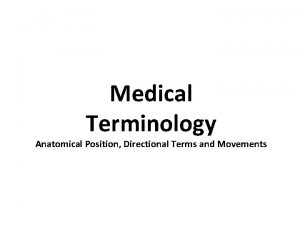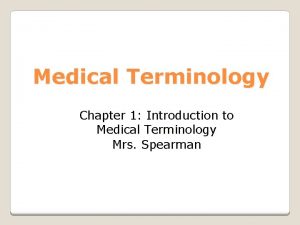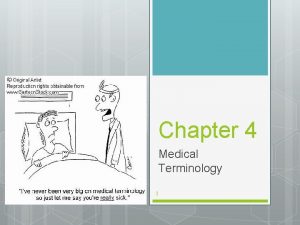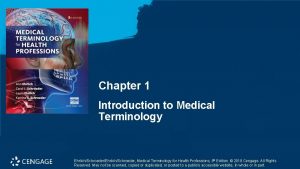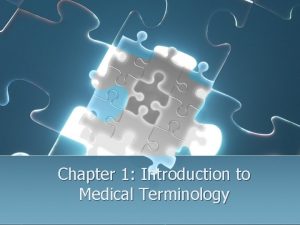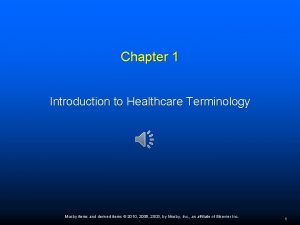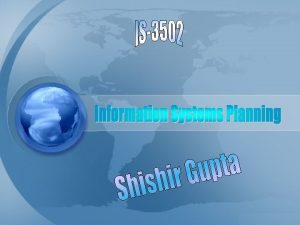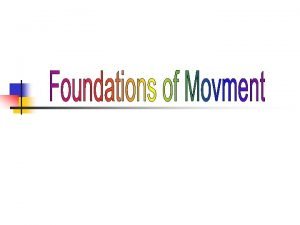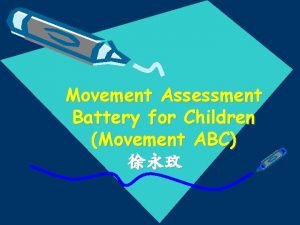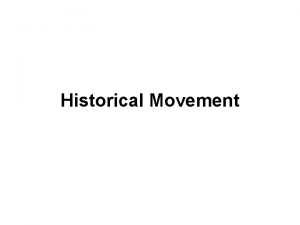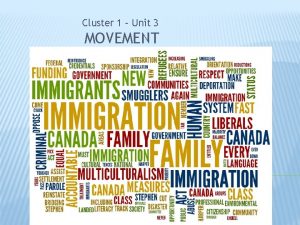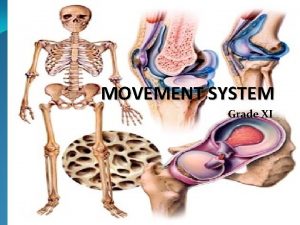Movement Terminology Course Content I II Introduction to


















- Slides: 18

Movement Terminology

Course Content I. II. Introduction to the Course Biomechanical Concepts Related to Human Movement III. Anatomical Concepts Related to Human Movement IV. Qualitative Analysis of Human Movement

Movement Terminology 1. 2. 3. 4. 5. Types of motion Reference systems Fundamental movements in the sagittal plane Fundamental movements in the frontal plane Fundamental movements in the transverse plane

Types of Motion motion – change in position with respect to some reference frame n What causes motion? n Force!!!

Linear Motion – Point Model translation rectilinear curvilinear Definition Role of COG?

Angular Motion – Link Model Axis rotation Role –of Definition fixed COG? or moving

General Motion

Reference Positions Fundamental Standing Position Fig 2. 9 Anatomical Standing Position

Sagittal Plane Mediolateral (ML)Axis Frontal Axis Bilateral Axis 2 -6 Planes & Axes

Sagittal Plane Frontal Plane Mediolateral (ML)Axis Anteroposterior (AP) Axis Sagittal Axis 2 -6

Sagittal Plane Frontal Plane Transverse Plane Mediolateral (ML)Axis Superior-Inferior (SI) Axis Anteroposterior (AP) Axis Longitudinal Axis Vertical Axis 2 -6

Movement Terminology 1. 2. 3. 4. 5. Types of motion Reference systems Fundamental movements in the sagittal plane Fundamental movements in the frontal plane Fundamental movements in the transverse plane

Sagittal Plane – Fundamental Movements n n n Flexion Extension Hyperextension Hyperflexion Plantar flexion Dorsiflexion Flexion and extension do not refer to muscle contraction!!!

Frontal Plane – Fundamental Movements n n n n n Abduction Adduction Left lateral flexion Right lateral flexion Hyperabduction Hyperadduction Radial deviation Ulnar deviation Inversion Eversion To observe, look at the plane, down the axis!!!

Transverse Plane – Fundamental Movements n Medial rotation ¨ Inward, n Internal Lateral rotation ¨ Outward, n n External Left rotation Right rotation Supination Pronation Forearm in neutral position

Transverse Plane – Fundamental Movements n n Horizontal adduction Horizontal abduction

Other Points n n n Circumduction combines sagittal (flexion, extension) and frontal plane (abduction, adduction) motions. Although inversion & eversion occur around the long axis of the bone like transverse plane movements, they are considered frontal plane movements because of the orientation of the foot in anatomical position. All movements defined in this slide show are rotational movement, even though we use the word rotation only for transverse plane motions.

Other Points (cont. ) n n Not all joints permit movement in all 3 planes – learn the planes of movement associated with each joint. Movement terms for each plane vary across joints – learn appropriate terminology for each joint.
 Characteristics of esp
Characteristics of esp Dynamic content vs static content
Dynamic content vs static content Arm anatomical term
Arm anatomical term Movement area
Movement area Meaning of axial movement
Meaning of axial movement One and half brick wall
One and half brick wall Course number and title
Course number and title Course interne course externe
Course interne course externe Medical terminology chapter 1 answers
Medical terminology chapter 1 answers Cyan o medical term
Cyan o medical term Cide medical term
Cide medical term Chapter 1 introduction to medical terminology
Chapter 1 introduction to medical terminology Chapter 1 introduction to medical terminology
Chapter 1 introduction to medical terminology Introduction to healthcare terminology
Introduction to healthcare terminology Introduction to veterinary terminology
Introduction to veterinary terminology Introduction to dynamic web content
Introduction to dynamic web content Content management system overview
Content management system overview Introduction to dynamic web content
Introduction to dynamic web content What is content means
What is content means


